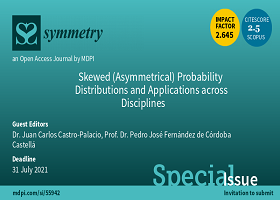Skewed (Asymmetrical) Probability Distributions and Applications across Disciplines
A special issue of Symmetry (ISSN 2073-8994). This special issue belongs to the section "Mathematics".
Deadline for manuscript submissions: closed (31 July 2021) | Viewed by 35238

Special Issue Editors
Interests: physics teaching; atomistic dynamics
Special Issues, Collections and Topics in MDPI journals
Interests: mathematical modeling; numerical simulation
Special Issues, Collections and Topics in MDPI journals
Special Issue Information
Dear Colleagues,
Skewed distributions are transversal and ubiquitous to all scientific disciplines. They have captured the attention of many researchers, as a deep understanding of their underlying probabilistic mechanisms is crucial in many fields. The right choice of the probability distribution for a non-normal stochastic process and the proper interpretation of its parameters can be very challenging and of enormous importance in fields like physics, chemistry, biology, and social sciences.
The guidelines for contributions to this Special Issue include (but are not limited to) the following topics, which are divided into two broad groups:
I. Methods and applications of skew distributions
- New applications and parameter interpretations of the main skewed distributions;
- Parameter estimation and statistical developments;
- Advances in modelling and simulations (i.e., Monte Carlo sampling) of processes in mathematics, physics, chemistry, biology, and social sciences;
- Efficient numerical methods to handle skewed distributions;
- Skewed distributions and the modelling of infectious diseases, which include COVID-19.
II. Skewed distributions in describing nature processes
- True meaning of skewed distributions in nature;
- Skewed distributions in psychological and neurological sciences;
- Non-normal distributions in biological and medical sciences;
- Skewed distributions in describing social processes;
- Origin and fundamental interpretations of skewed distributions in mathematics, physics, chemistry, biology, and social sciences.
Dr. Juan Carlos Castro-Palacio
Prof. Dr. Pedro José Fernández de Córdoba Castellá
Guest Editors
Manuscript Submission Information
Manuscripts should be submitted online at www.mdpi.com by registering and logging in to this website. Once you are registered, click here to go to the submission form. Manuscripts can be submitted until the deadline. All submissions that pass pre-check are peer-reviewed. Accepted papers will be published continuously in the journal (as soon as accepted) and will be listed together on the special issue website. Research articles, review articles as well as short communications are invited. For planned papers, a title and short abstract (about 100 words) can be sent to the Editorial Office for announcement on this website.
Submitted manuscripts should not have been published previously, nor be under consideration for publication elsewhere (except conference proceedings papers). All manuscripts are thoroughly refereed through a single-blind peer-review process. A guide for authors and other relevant information for submission of manuscripts is available on the Instructions for Authors page. Symmetry is an international peer-reviewed open access monthly journal published by MDPI.
Please visit the Instructions for Authors page before submitting a manuscript. The Article Processing Charge (APC) for publication in this open access journal is 2400 CHF (Swiss Francs). Submitted papers should be well formatted and use good English. Authors may use MDPI's English editing service prior to publication or during author revisions.
Benefits of Publishing in a Special Issue
- Ease of navigation: Grouping papers by topic helps scholars navigate broad scope journals more efficiently.
- Greater discoverability: Special Issues support the reach and impact of scientific research. Articles in Special Issues are more discoverable and cited more frequently.
- Expansion of research network: Special Issues facilitate connections among authors, fostering scientific collaborations.
- External promotion: Articles in Special Issues are often promoted through the journal's social media, increasing their visibility.
- e-Book format: Special Issues with more than 10 articles can be published as dedicated e-books, ensuring wide and rapid dissemination.
Further information on MDPI's Special Issue polices can be found here.






